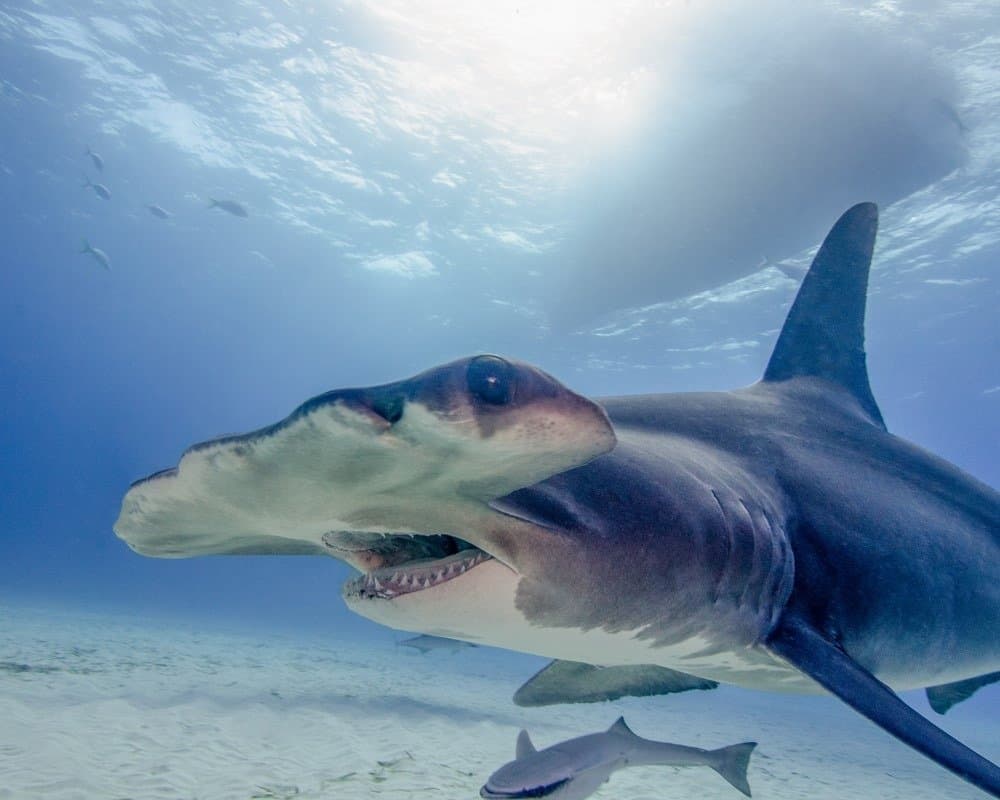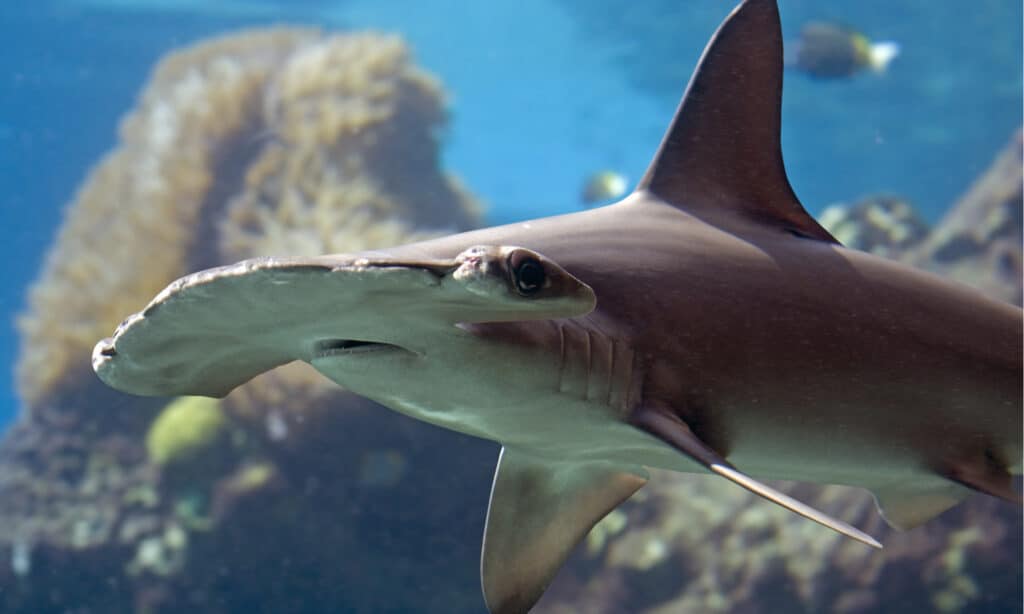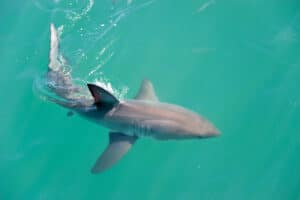The scalloped hammerhead shark and the great hammerhead shark are two of nine hammerhead shark species. The scalloped hammerhead shark is scientifically known as the Sphyrna lewini while the great hammerhead shark bears the scientific name ‘Sphyrna mokarran.’ Both sharks belong to the genus Sphyrna and the family Sphyrnidae along with the seven other species.
While both of these hammerhead sharks are close relations, there are some differences between them. And that exactly is what we are going to be looking into; their differences, peculiarities and basically how they compare with each other. Let’s get into it already, huh?
Comparing Scalloped Hammerhead Shark Vs Great Hammerhead Shark
| Scalloped Hammerhead Shark | Great Hammerhead Shark | |
|---|---|---|
| Size | Length: Up to 14ft Weight: Up to 335lbs | Length: Up to 20ft Weight: Up to 1280lbs |
| Appearance | Hammer-shaped head, an indentation in the middle of the expanded head, smaller notches around the head making it a scalloped head. | Hammer-shaped head, straight front margin, and a shallow notch in the center of the head. |
| Location and Habitat | Worldwide; open marine waters, island shelves, bays, and estuaries. | Worldwide; shallow waters in continental shelves and island terraces. |
| Diet | Carnivorous; Squids, crustaceans, bony fishes, smaller sharks, sting rays, octopuses | Carnivorous; sardines, conger eels, octopuses, stingrays, black tip reef sharks, angel sharks, etc. |
| Gestation Period | Period: 8-12 months Litter size: 12-38 pups | Period: 11 months Litter size: 20-40 pups |
| Lifespan | 20-30 years | 20-30 years |
Key Differences Between Scalloped Hammerhead Shark And Great Hammerhead Shark
The major difference between scalloped hammerhead sharks and great hammerhead sharks lies in their size and appearance. There are other subtle differences and individual peculiarities, some of which we will explore as we proceed.
Scalloped Hammerhead Shark vs Great Hammerhead Shark: Size

Great hammerhead sharks have a maximum length of 20 feet.
©Brent Barnes/Shutterstock.com
The scalloped hammerhead shark and the great hammerhead shark differ greatly in both length and weight. The scalloped hammerhead shark measures up to 14ft in length and up to 335lbs in weight. While that’s a lot, it is inferior to the size of the great hammerhead shark which has a max length of up to 20ft and a max weight of up to 1280lbs. As a matter of fact, the great hammerhead shark likely got the “Great” in its name as a result of its humongous size and its position as the biggest hammerhead shark.
Scalloped Hammerhead Shark vs Great Hammerhead Shark: Appearance
Scalloped hammerhead sharks and great hammerhead sharks also differ in terms of appearance. While they both have hammer-shaped heads, scalloped hammerhead sharks have a small but mildly conspicuous indentation in the center of their large heads and smaller notches around the head that make it scalloped. Also, the first dorsal fin is much bigger than the second and is shaped like a sickle while the second has a curved rear edge. There is not much to be said about the color besides a dark gray or black pectoral fin tip, a gray dorsum, and a white ventral surface/underbelly.
As for the great hammerhead shark, they have a nearly straight anterior head margin and a shallow notch in the center of the head. However, there are no notches around the head to give it the scalloped shape obtainable in scalloped hammerhead sharks.
Scalloped Hammerhead Shark vs Great Hammerhead Shark: Location And Habitat

Scalloped hammerhead sharks are often found close to continental and island shelves as well as estuaries and bays.
©Ian Scott/Shutterstock.com
The scalloped hammerhead shark and the great hammerhead shark are both found in oceans around the world including the Atlantic, Pacific, and Indian Oceans. Scalloped hammerhead sharks prefer open marine waters and they are often found close to continental and island shelves as well as estuaries and bays. They often switch between different habitats daily; they migrate from off-shore hunting areas to island shelves as well as enclosed bays and estuaries at dawn. Further in the day, they would move to reefs where females are known to gather in schools and interact.
Great hammerhead sharks can be found in both deep and shallow waters. Experts have noted that during summer, they like to migrate northwards. They also love to inhabit coral reefs with plenty of food.
Scalloped Hammerhead Shark vs Great Hammerhead Shark: Diet
As you can probably guess, scalloped hammerhead sharks and great hammerhead sharks are both carnivorous. Also, while they have a similar diet, the great hammerhead shark has a broader ranger, possibly because of its immense size.
The scalloped hammerhead shark has a diet comprising squids, crustaceans, bony fishes, sting rays, smaller sharks, and even octopuses. Similarly, the great hammerhead shark often feeds on stingrays, sardines, angel sharks, reef sharks, conger eels, and octopuses amongst others.
Both species have a seemingly special preference for stingrays as scientists often find stingray spines and remains somewhere in their mouths and this is the case for other hammerhead species as well.
Scalloped Hammerhead Shark vs Great Hammerhead Shark: Gestation Period And Litter Size

The great hammerhead shark has a litter size of 20 to 40 pups.
©Sail Far Dive Deep/Shutterstock.com
The scalloped hammerhead shark and the great hammerhead shark are both viviparous as opposed to being oviparous. This means their pups are not laid as eggs but they are born alive. However, gestation periods and litter size differ slightly. For the scalloped hammerhead shark, the gestation period is 8-12 months while it is 11 months for the great hammerhead shark. Also, the litter size for the scalloped hammerhead shark is 12-38 pups while the great hammerhead bears litters of about 20-40 pups, and may sometimes go as low as 6 and as high as 55.
Scalloped Hammerhead Shark vs Great Hammerhead Shark: Lifespan
The scalloped hammerhead shark and the great hammerhead shark have very similar life expectancies as both species are expected to live for around 20-30 years. We should also add that both species are listed as critically endangered by the IUCN owing to declining populations over the years.
Up Next:
- Hammerhead Shark Location: Where do hammerhead sharks live?
- The 10 Biggest Sharks Near North Carolina Beaches
- Great White Sharks’ In Hawaii
The photo featured at the top of this post is ©
Thank you for reading! Have some feedback for us? Contact the AZ Animals editorial team.






